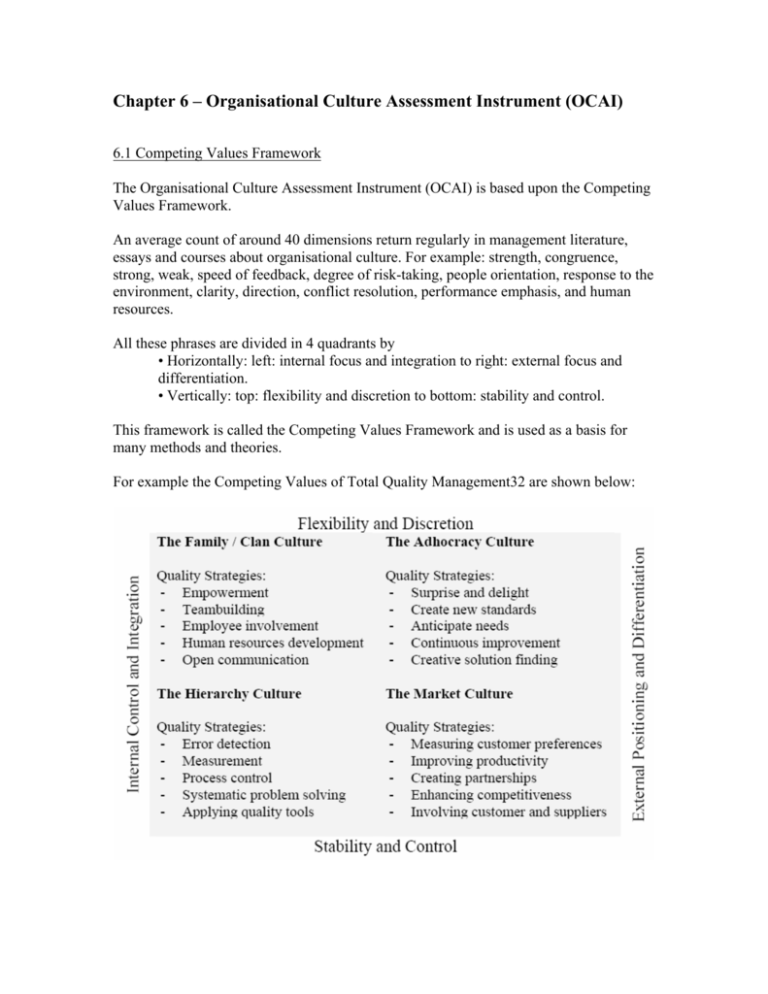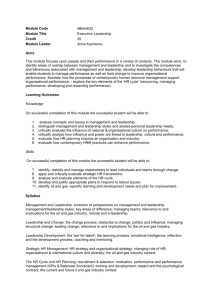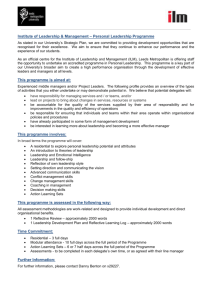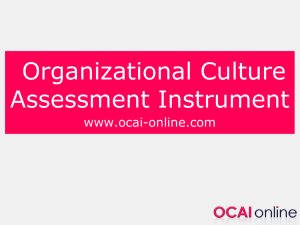Chapter 6 – Organisational Culture Assessment Instrument (OCAI)
advertisement

Chapter 6 – Organisational Culture Assessment Instrument (OCAI) 6.1 Competing Values Framework The Organisational Culture Assessment Instrument (OCAI) is based upon the Competing Values Framework. An average count of around 40 dimensions return regularly in management literature, essays and courses about organisational culture. For example: strength, congruence, strong, weak, speed of feedback, degree of risk-taking, people orientation, response to the environment, clarity, direction, conflict resolution, performance emphasis, and human resources. All these phrases are divided in 4 quadrants by • Horizontally: left: internal focus and integration to right: external focus and differentiation. • Vertically: top: flexibility and discretion to bottom: stability and control. This framework is called the Competing Values Framework and is used as a basis for many methods and theories. For example the Competing Values of Total Quality Management32 are shown below: Total Quality Management (TQM) is one of the most applied organisational change methods in the last two decades. It is focused on increasing an organisations’ effectiveness by setting quality objectives. The number of successful implementations of TQM is not sky-high, Cameron and Quinn derived from TQM literature that this has mainly two causes33: 1. only partial deployment; 2. failure to integrate TQM and culture change. Each quadrant is named after its most recognisable characteristics: Family or Clan, Adhocracy, Market and Hierarchy. Cameron and Quinn have named the quadrant that lies in between ‘internal focus and integration’ and ‘flexibility and discretion’ the Clanquadrant. ‘Clan’ has a bit of a negative sound or emotional value, and it can just as good be called ‘Family’. The questionnaire is divided in six clusters. Each part consists of four statements amongst which the respondents are to divide one hundred points. The four statements are linked to the four quadrants. The first phrase can be placed in quadrant A (Family), the second phrase can be placed in quadrant B (Adhocracy), etc. The six clusters of phrases are the following: • Dominant Characteristics • Organisational Leadership • Management of Employees • Organisational Glue • Strategic Emphases • Criteria of Success The questionnaire can be found in Appendix III. Scores given to each quadrant are totalled and the averages are transposed onto the graph. The graphs are a visual representation that can be easily interpreted and compared with other outcomes. In order to be able to determine not only the current Organisational Culture, but the Organisational Culture that is desired by the employees as well, a set of two questionnaires has been handed out. One to fill out bearing in mind the situation as it has been for the last couple of years. The second and identical questionnaire, to complete when thinking of what would be the perfect working environment as the respondent would like to experience it. The questionnaire has been distributed amongst IS personnel at the six DHL IS entities: Danzas NL, Danzas Belux, VGL NL, VGL Belux, DHL NL, DHL Belux. Or locationwise: Rotterdam Boompjes, Grimbergen, Driebergen, Ternat, Hoofddorp en Diegem. A total number of 222 sets of questionnaires were handed out throughout the Benelux IS departments. When analysing the outcome there are three different kinds: - the current Organisational Culture (by the employees); - the desired Organisational Culture (by the employees); - the required Organisational Culture (by management). 6.4 The required 3D IS Benelux Organisational Culture Having taken a look at all the outcomes received from the various departments and carefully reading and interpreting the graphs from the book of Cameron and Quinn, the workgroup decided upon creating a required Organisational Culture for the 3D IS Benelux department: In values: Family: 20 – Adhocracy: 20 – Market: 37 – Hierarchy: 23. The choice for this required Organisational Culture is based upon analysis of the DHL departmental scores as well as examples from Cameron and Quinn. 6.4.1 From analysis of DHL departmental scores In a service providing department the best developed characteristic should undoubtedly be the Market focus. It is of most importance to properly value the customers’ needs if delivering quality service is the main focus. Customers of the 3D IS Benelux department are both internal and external users. Users of for example computers, networks, applications, telephony and information databases. When it is well known what services and support the customers desire exactly, it is easier to deliver the proper services and support them. Extensive communication with the IS customers is a vital source of information to obtain the necessary knowledge on what is wished for. Listening to the customer is a key issue. Keeping track of developments in the rapidly changing environment of Information Technology is also important. Applying new techniques that can improve the customers’ business processes or just make life easier, simply enhances the service level. Customers might ask for new techniques themselves, though it is much better to be able to surprise them with improvements. Keeping in close contact with suppliers is a useful method for this. Both Family and Adhocracy are characteristics that are equally important as they are highly valued by IS personnel. This can be concluded from the questionnaires answered about the desired Organisational Culture. IS personnel enjoy working in a friendly environment that leaves them sufficient space to develop their own solutions and take their own decisions. Additionally they prefer not to be lived by the pleasing of the customer. From a management point of view Family and Adhocracy are, in this case, only necessary to keep personnel satisfied. If DHL would have been an organisation in growth and still be working on obtaining a larger market share, the developing and thus Adhocracy would be of much more importance. Then there would be markets and competitors to conquer, which is not the case in this situation. Family feeling largely contributes to the working atmosphere amongst personnel. In order to be a professionally operating organisation, the Family feeling should not be too present as it can slow down change and progress. A group of employees that is extremely cohesive can be very difficult to handle. Hierarchy is absolutely necessary as the 3D IS Benelux department is large and complex. The various functions often have overlap with one another. Processes, procedures and line-management increase the clarity about responsibilities, which can also be shared between functions. 6.4.2 From examples from Cameron & Quinn In Cameron and Quinns’ Diagnosing and Changing Organisational Culture many examples are presented for various organisations and industry groups. The organisations that are closest to the 3D IS Benelux department are the “Multinational Manufacturer” and the branch of “Retail and Wholesale Trade”. The first because of the multinational aspect, the second because of the customer focus. A balance between - the above visual representations of two organisations and - the earlier written analysis of the questionnaires reviewed, result in a proposal for a required Organisational Culture for 3D IS Benelux. This proposal matched with the ideas the workgroup had after reviewing the received questionnaires and has been well received by the IS Management Team.









